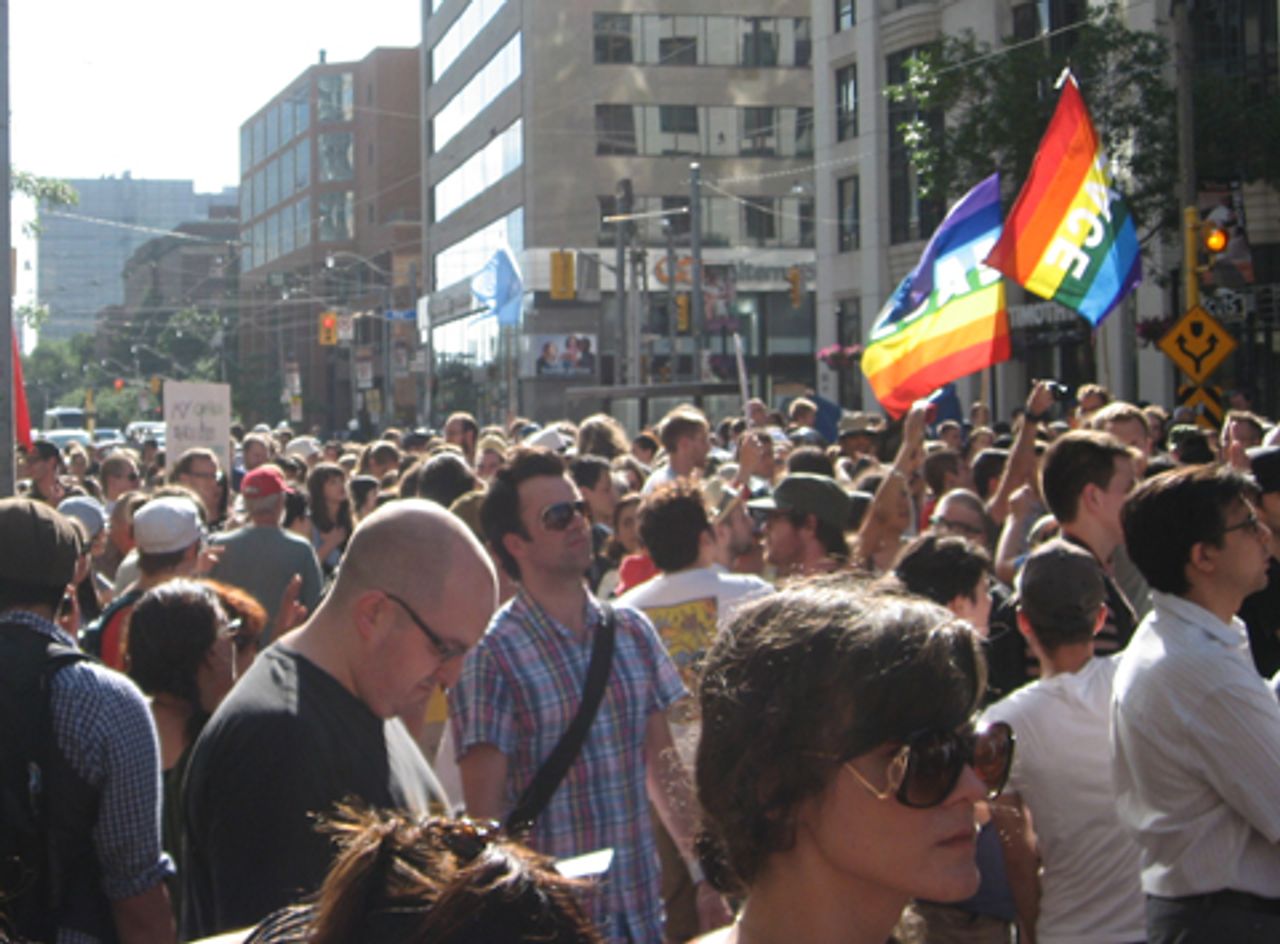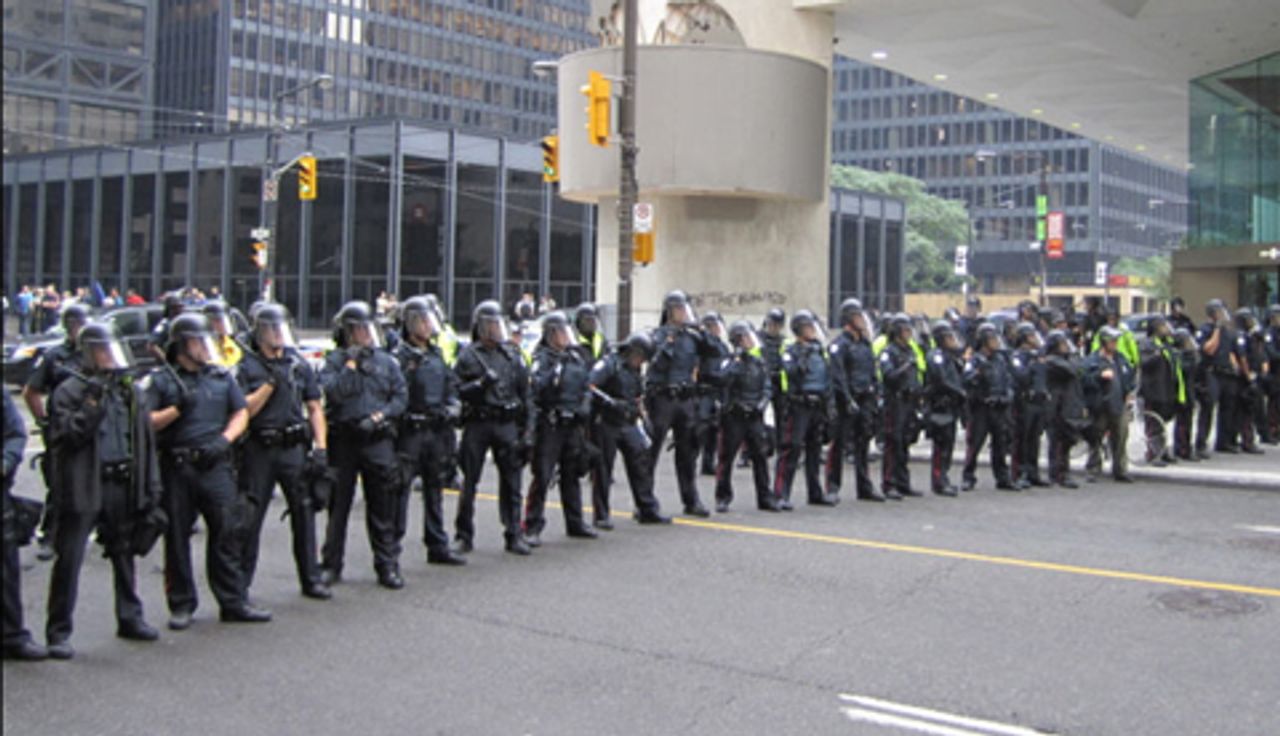Police provocations on the streets of Toronto continued Monday evening as thousands of city residents rallied in front of the municipal police headquarters to protest the martial law tactics let loose against the population over the weekend.
As crowds began to spill out into the road outside the headquarters, police cordoned off the area, preventing hundreds of others from joining in. Several individuals who attempted to cross the police cordon were summarily arrested. Already, by six in the evening some 2,000 people had gathered in the vicinity, outraged by police actions.
Over the weekend, while the leaders of the G20 met behind a barbed-wire perimeter at Toronto’s Metro Convention Centre to discuss another round of austerity measures against the international working class, the 14,000 strong “Integrated Security Force” had rampaged through the ranks of peaceful demonstrators, arresting over 900 individuals and incarcerating them in a filthy, make-shift holding pen in the city’s east end.
Over the course of the past 72 hours protestors have been bludgeoned, kicked, tear gassed, trampled by police horses and shot at with rubber and plastic bullets. Homes have been raided for “preventative arrests” without a warrant. Journalists covering these unprecedented events have been arrested and assaulted.
 A section of the Toronto protest
A section of the Toronto protestDemonstrators have been hauled into detention cages, strip searched and denied legal counsel. There, detainees suffering from concussion and deep lacerations were denied medical attention. A diabetic entering into shock was denied treatment for four hours.
The “kennel” as it was dubbed by police guards, was crammed with people arrested for such egregious offences as carrying “dangerous weapons” such as protest signs and noise-makers. Smokers carrying lighters have been accused of possessing “incendiary devices”. Youth with the temerity to wear black clothing have been swept up by the police dragnet in a program dubbed “catch and release” by rank-and-file cops. (A collection of eyewitness accounts was published by the Toronto Star here.)
In one particularly provocative action, hundreds of heavily armed riot police corralled some 200 people Sunday night at a downtown street-corner, forcing them to stand in a driving thunderstorm for four hours. This “kettling operation” detained not only youth demonstrating against the G20 but commuters heading home from weekend shopping, dozens of citizens departing from world cup soccer celebrations, journalists covering the police build-up and entire families resident in the area. The scenes of drenched and shivering people, crying children and distressed family pets have struck a chord amongst broad layers of the city’s populace.
 Police block demonstrators
Police block demonstratorsNews anchors covering Monday evening’s protest against police brutality have been shocked by the size of the spontaneous outpouring of opposition to the repressive measures unleashed against the citizenry. As the march proceeded from downtown police headquarters towards the site of Sunday night’s “human corral”, people heading home from work joined the procession. A cacophony of car horns, stuck in traffic, rhythmically beeped in time with chants of “No police state”! Thousands of riot and mounted police, aware of the symbolism of the march, moved to block the route towards the kettling site.
Blocked from heading westward, the crowd marched to Toronto’s Nathan Phillips Square, the seat of the municipal government, shouting “Shame, Shame” in criticism of the social democratic mayor, David Miller, who issued statements over the weekend supporting the police repression.
The march then proceeded to Queen’s Park, the grounds of the provincial legislature, to register its opposition to the Liberal government of Dalton McGuinty that earlier this month secretly passed a provision massively expanding police powers.
Security forces had claimed the right to take over Toronto’s financial and entertainment districts under the federal Foreign Missions and International Organizations Act. Following the 2001 demonstrations against the Summit of the Americas in Quebec City, the Liberal government of Jean Chretien amended the act to stipulate that “the Royal Canadian Mounted Police may take appropriate measures, including controlling, limiting or prohibiting access to any area to the extent and in a manner that is reasonable in the circumstances”. The vague terminology, and the absence of any reference to the rights of free movement and free speech that are reputedly guaranteed under Canada’s Charter of Rights and Freedoms, have provided police organizations with the ability to impose martial-law-like restrictions at will.
But even this carte-blanche was deemed inadequate by Toronto Police Chief Bill Blair and McGuinty. At the “extraordinary request” of the police chief, the provincial cabinet on June 2 secretly passed a new regulation under the Ontario Public Works Protection Act that allows police to arrest anyone within five meters of the security zone who refuses to submit to a request for identification or a search of their person.
The new law, in effect until June 28, was not publicized. Its public exposure occurred when it appeared without notice on a provincial e-laws database last week. Despite hundreds of briefings given to the citizens of Toronto over the past month, police consistently withheld this information. “It reminds me a little bit of the War Measures Act,” said Nathalie Des Rosiers of the Canadian Civil Liberties Association.
To date, Premier McGuinty and his entire cabinet have remained unavailable for comment.
In a press conference given by Blair on Saturday evening, the police chief dismissed criticism of McGuinty’s anti-democratic measure, stating that police did not need the provision to arrest so-called suspicious people wherever and whenever they saw fit.
On Monday morning Amnesty International, the Canadian Civil Liberties Association and several journalistic societies called for an inquiry into the police actions. So naked has been the assault on democratic rights that even sections of Canada’s mainstream press have been forced to denounce the “excesses”. The Toronto Star, the country’s largest circulation daily, featured a front page editorial Monday morning dubbing the Conservative Harper government’s $1.2 billion G20 security plan as “a brutal spectacle that failed a city and its people.”
Throughout the weekend, Prime Minister Stephen Harper’s office and the media trumpeted the vandalism of a small group of “Black Bloc” anarchists who, on Saturday, broke away from police lines to smash shop windows and bank ATM’s and set alight several police cruisers. It was these actions, claimed the police, which brought about their repressive measures.
But police attacks on activists preceded these actions by several days. Already dozens of protestors had been arrested. “Preventative” raids on the homes of known protest organizers began on Friday evening. In the months prior to the G20 summit, organizers had been followed by police, their meetings aggressively “monitored” and “visits” paid to their homes and places of work.
Moreover, over the past 24 hours, more evidence has surfaced that put into serious question the police version of events around the vandalism of Saturday. The actions, including the torching of police cars, were carried out without any intervention from the police.
Today, close-up photographs of those attacking the cruisers show that several of them were attired in footwear closely resembling that issued to the squads of riot policemen deployed on the streets. One reporter noted that a gas cap on one of the cruisers had been removed prior to the arrival of the “ Black Bloc.” Others questioned why cruisers were left isolated and unattended by the police.
Leo Broderick, vice-chair of the Council of Canadians and a participant in the demonstration held Saturday afternoon, provided the following observation: “I returned from viewing the burning of police cars on Bay Street and the latest on Queen Street. I am convinced this is a police set up. My first clue of a pending entrapment was on leaving Queens Park and we were confronted with an empty police car blocking our way. Very peculiar. We all walked around it….This evening on Queen Street a police car was simply left there. Supposedly broken down. I saw the car there abandoned, and was puzzled. No police around. Earlier when I was there the police were everywhere. But they were not there when this car was torched.”
